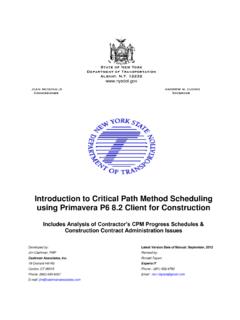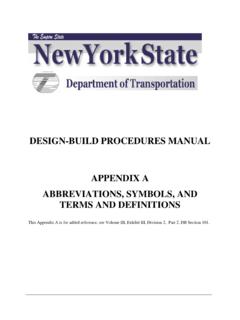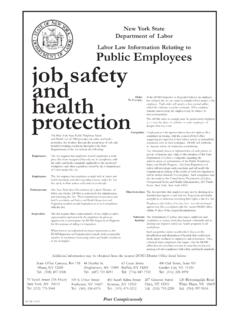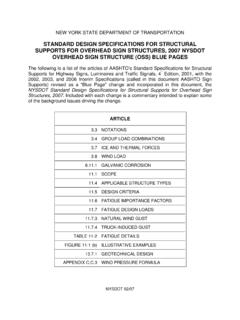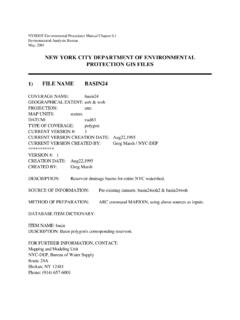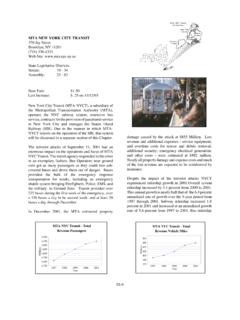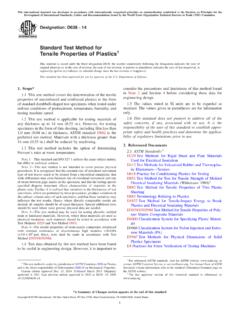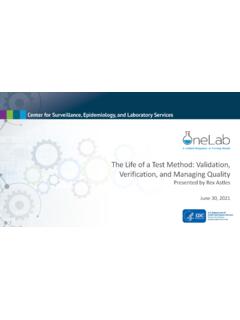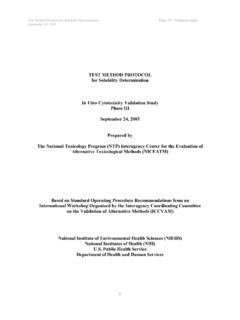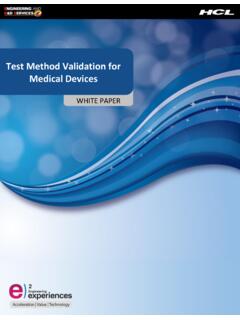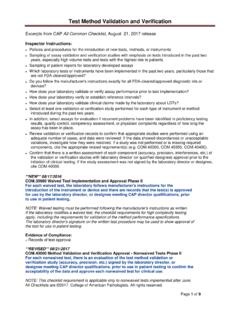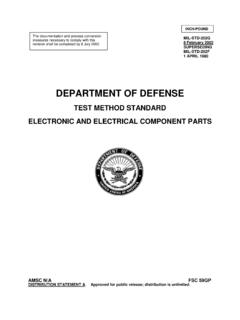Transcription of TEST METHOD FOR THE DETERMINATION OF pH VALUE OF …
1 TEST METHOD FOR THE DETERMINATION OF pH VALUE OF WATER OR SOIL BY pH METER GEOTECHNICAL TEST METHOD GTM-24 Revision #3 AUGUST 2015 EB 15-025 Page 1 of 5 GEOTECHNICAL TEST METHOD : TEST METHOD FOR DETERMINATION OF pH VALUE OF WATER OR SOIL BY pH METER GTM-24 Revision #3 STATE OF NEW YORK DEPARTMENT OF TRANSPORTATION GEOTECHNICAL ENGINEERING BUREAU AUGUST 2015 EB 15-025 Page 2 of 5 TABLE OF CONTENTS 1. SCOPE ..3 2. APPARATUS AND MATERIALS ..3 3. PROCEDURE ..3 A. Water pH DETERMINATION ..3 B. Soil pH DETERMINATION ..4 4. PRECAUTIONS ..5 EB 15-025 Page 3 of 5 1. SCOPE This test METHOD is the procedure for determining the pH of water or soil samples by use of a pH meter. However, if the pH of any industrial by-product material ( : cinders, flyash, etc.)
2 Is required, the procedure under will be followed. 2. APPARATUS AND MATERIALS A pt. (50 mL), wide-mouth glass beaker with a watch glass for cover. If lightweight material is to be tested, it may be necessary to increase beaker size up to a maximum of pt. (250 mL). A pH meter, suitable for laboratory or field analysis, with either one or two electrodes. Standard buffer solutions of known pH values - standards to be used are pH of , , and Distilled water. A teaspoon or small scoop. A thermometer capable of reading 77 18 F (25 10 C) to the nearest C. A in. ( mm) sieve conforming to the requirements of AASHTO Designation M-92-91 (excluding Column 7, pg. 87) and a pan. A glass stirring rod. A scale, minimum capacity of lb. (500 g).
3 It shall be accurate to and be readable to g. 3. PROCEDURE A. Water pH DETERMINATION Stir the water sample vigorously using a clean glass stirring rod. Pour a 40 mL 5 mL sample into the glass beaker using the watch glass for a cover. Let the sample stand for a minimum of one hour to allow the temperature to stabilize, stirring it occasionally while waiting. Measure the temperature of the sample and adjust the temperature controller of the pH meter to that of the sample temperature. This adjustment should be done just prior to testing. EB 15-025 Page 4 of 5 On meters with an automatic temperature control, follow the manufacturer's instructions. Standardize the pH meter by means of the standard solutions provided. Temperature and adjustments must be performed as stated under (See Note 1).
4 Immerse the electrode(s) of the pH meter into the water sample and turn the beaker slightly to obtain good contact between the water and the electrode(s). (See Note 2). The electrode(s) require immersion 30 seconds or longer in the sample before reading to allow the meter to stabilize. If the meter has an auto read system, it will automatically signal when stabilized. Read and record the pH VALUE to the nearest tenth of a whole number. If the pH meter reads to the hundredth place, a round off rule will apply as follows: If the hundredth place digit is less than 5, leave the tenth place digit as is. If it is greater than 5, round the tenth place digit up one unit. If the hun-dredth place digit equals 5, round the tenth place digit to the nearest even number.
5 Rinse the electrode(s) well with distilled water, then dab lightly with tissues to remove any film formed on the electrode(s). Caution: Do not wipe the electrodes, as this may result in polarization of the electrode and consequent slow response. (See Note 3). B. SOIL pH DETERMINATION The material must be separated on the in. ( mm) sieve. Only the minus in. ( mm) material is to be used for testing. Weigh and place 30 g of soil into the glass beaker. Add 30 g of distilled water to the soil sample. Stir to obtain a soil slurry and then cover with watch glass. The sample must stand for a minimum of one hour, stirring every 10 to 15 minutes. This is to allow the pH of the soil slurry to stabilize. After one hour, the temperature of the sample should be stabilized.
6 Measure the temperature of the sample and adjust the temperature controller of the pH meter to that of the sample temperature. This adjustment should be done just prior to testing. On meters with an automatic temperature control, follow the manufacturer's instructions. EB 15-025 Page 5 of 5 Standardize the pH meter by means of the standard solutions provided. Temperature and adjustments must be performed as stated under (See Note 1). Immediately before immersing the electrode(s) into the sample, stir the sample well with a glass rod. Place the electrode(s) into the soil slurry solution and gently turn beaker to make good contact between the solution and the electrode(s). DO NOT place electrode(s) into the soil; only into the soil slurry solution.
7 (See Note 2). The electrode(s) require immersion 30 seconds or longer in the sample before reading to allow the meter to stabilize. If the meter has an auto read system, it will automatically signal when stabilized. Read and record the pH VALUE to the nearest tenth of a whole number. If the pH meter reads to the hundredth place, a round off rule will apply as follows: If the hundredth place digit is less than 5, leave the tenth place digit as is. If it is greater than 5, round the tenth place digit up one unit. If the hun-dredth place digit equals 5, round the tenth place digit to the nearest even number. Rinse the electrode(s) well with distilled water, then dab lightly with tissues to remove any film formed on the electrode(s). Caution: Do not wipe the electrodes as this may result in polarization of the electrode(s) and consequent slow response.
8 (See Note 3). NOTE 1 - To standardize the pH meter, use the pH buffer standard solution plus the other standard solution which is nearest the estimated pH VALUE of the sample to be tested. If the manufacturer's instructions indicate a METHOD other than that noted above, then those instructions must be followed. NOTE 2 - When immersing electrode(s) into the glass beaker, care should be taken not to hit the bottom or side, causing damage to electrode(s). NOTE 3 - If polarization does occur, as indicated by a slow response, rinse the electrode(s) and dab lightly again. 4. PRECAUTIONS Periodically check for damage to electrode(s). Electrode tips should be kept moist during storage. Follow manufacturer's instructions.
